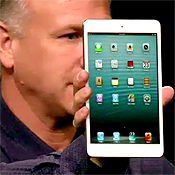 Huff Post says: Apple’s new iPad Mini costs $130 more than the two other best handheld tablets on the market of similar size, Amazon’s Kindle Fire HD and Barnes & Noble’s NOOK HD. And while the price difference between iPad mini ($329) and Kindle Fire HD/NOOK HD ($199) is crystal clear, the justification for said price difference is, I am afraid, quite blurry.
Huff Post says: Apple’s new iPad Mini costs $130 more than the two other best handheld tablets on the market of similar size, Amazon’s Kindle Fire HD and Barnes & Noble’s NOOK HD. And while the price difference between iPad mini ($329) and Kindle Fire HD/NOOK HD ($199) is crystal clear, the justification for said price difference is, I am afraid, quite blurry.
Apple outed its iPad mini at an event on Tuesday afternoon, adding another high-quality device to an already-crowded 7-inch tablet market. The iPad mini is fast, well-built, and features hundreds of thousands apps from Apple’s excellent App Store.
If you’re shopping for a handheld tablet, you now have to decide between this new iPad mini, the Kindle Fire HD, the NOOK HD, the Nexus 7, and the “old” 2011 Kindle Fire, the price of which has been reduced to a tantalizing $159. Inded, it is a packed field: It’s like the 2012 Republican primaries all over again, except, unlike the GOP candidates, all of these tablets computers can count to three.
As you begin to shop, the first number that’s going to differentiate these tablets for you, I would think, is price: The iPad mini starts at $329, compared to $199 for the brand new NOOK HD, Kindle Fire HD and Google Nexus 7. That’s a $130 difference, a lot of money for those of us who don’t own horses competing in Olympic dressage.
The second thing you might notice — or, that you do notice, if you’re a numbers nerd like I am — is screen resolution and pixel desnity. Without getting too geeky on you, the NOOK HD and Kindle Fire HD feature much, much crisper screens than the iPad mini. For those that care: The iPad mini has a resolution of 1024×780, with 163 pixels-per-inch; the Kindle Fire HD has a 1280×800 resolution, with 216 pixels-per-inch; and the NOOK HD has a 1440×900 resolution, with 243 pixels-per-inch. In this case, higher is better, lower is worse; Apple’s screen doesn’t stack up, and it comes affixed to a device that is $130 more expensive than the competition.
As many gadget reviewers noted when the iPad 3 with Retina display came out, going from the iPad 3 back to the iPad 2 is like switching from HDTV to a non-HD feed. You’re spoiled by the extra resolution, and the supreme density of pixels, and when you switch back and forth between a Retina and non-Retina device, the difference is noticeable. The non-Retina device seems downright blurry or fuzzy compared to the Retina device.
 As Apple faces increased scrutiny for hiring foreign firms to manufacture its products overseas, CEO Tim Cook says that the U.S.-based company is looking to bring more jobs back home.
As Apple faces increased scrutiny for hiring foreign firms to manufacture its products overseas, CEO Tim Cook says that the U.S.-based company is looking to bring more jobs back home.





